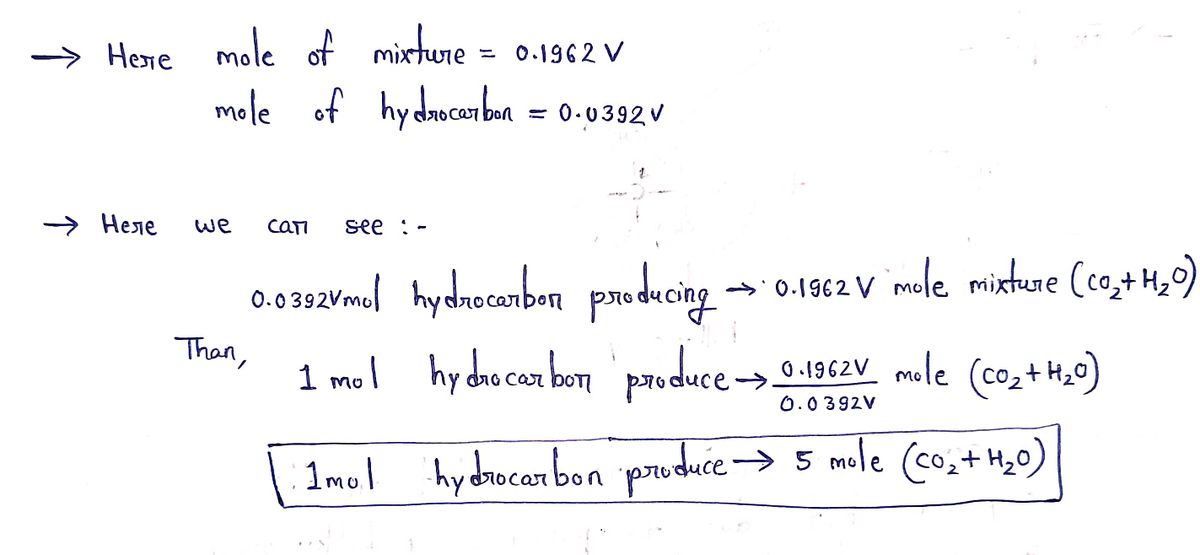Chemistry
10th Edition
ISBN:9781305957404
Author:Steven S. Zumdahl, Susan A. Zumdahl, Donald J. DeCoste
Publisher:Steven S. Zumdahl, Susan A. Zumdahl, Donald J. DeCoste
Chapter1: Chemical Foundations
Section: Chapter Questions
Problem 1RQ: Define and explain the differences between the following terms. a. law and theory b. theory and...
Related questions
Question
100%
At the end of this, how did we go from a 5 to 1 ratio moles to 2CO2 and 3H2O?

Transcribed Image Text:Number of moles of hydrocarbon is calculated as follows:
PV = nRT
Rearrange above equation for n.
PV = nRT
n = RT
Value of Vis V.
Value of R is 0.082057 L atm K-¹.mol-¹.
Value of Tis 298 K.
Value of P is 0.959 atm.
Substitute the values in above equation for moles of hydrocarbon.
n = RT
(0.959 atm) (V)
(0.082057 L-atm-K-¹-mol-¹) (298 K)
= 0.0392 V mol
Hence, number of moles of hydrocarbon is 0.0392 V mol.
Value of Vis 4V.
Value of R is 0.082057 L atm K-¹ mol-¹.
Value of Tis 375 K.
Value of P is 1.51 atm.
Substitute the values in above equation for moles of mixture of gases.
n = RT
(1.51 atm)(4V)
(0.082057 L-atm-K-¹-mol-¹)(375 K)
= 0.1962 V mol
Hence, number of moles of carbon dioxide and water vapor mixture is 0.1962 V mol.
Ratio of number of moles of hydrocarbons to mixture of gases is as follows:
number of moles of hydrocarbon
Ratio =
number of moles of mixture
Value of number of moles of hydrocarbon is 0.0392 V mol.
Value of number of moles of mixture is 0.1962 V mol.
Substitute values in above expression.
Ratio =
number of moles of mixture
number of moles of hydrocarbon
=
Conclusion
0.1962 V mol
0.0392 V mol
Hence, total number of moles of mixture of carbon dioxide and water vapor is 5 and hydrocarbon is 1.
Therefore, combustion reaction of hydrocarbon so formed is as follows:
Hydrocarbon + O2 → 2CO2 + 3H₂O
From above reaction it is evident that number of carbon and hydrogen in molecular formula of hydrocarbon
is 2 and 6. Hence, molecular formula of hydrocarbon is C₂H6.
Molecular formula of hydrocarbon is C₂H6.
Expert Solution
Step 1

Trending now
This is a popular solution!
Step by step
Solved in 3 steps with 3 images

Knowledge Booster
Learn more about
Need a deep-dive on the concept behind this application? Look no further. Learn more about this topic, chemistry and related others by exploring similar questions and additional content below.Recommended textbooks for you

Chemistry
Chemistry
ISBN:
9781305957404
Author:
Steven S. Zumdahl, Susan A. Zumdahl, Donald J. DeCoste
Publisher:
Cengage Learning

Chemistry
Chemistry
ISBN:
9781259911156
Author:
Raymond Chang Dr., Jason Overby Professor
Publisher:
McGraw-Hill Education

Principles of Instrumental Analysis
Chemistry
ISBN:
9781305577213
Author:
Douglas A. Skoog, F. James Holler, Stanley R. Crouch
Publisher:
Cengage Learning

Chemistry
Chemistry
ISBN:
9781305957404
Author:
Steven S. Zumdahl, Susan A. Zumdahl, Donald J. DeCoste
Publisher:
Cengage Learning

Chemistry
Chemistry
ISBN:
9781259911156
Author:
Raymond Chang Dr., Jason Overby Professor
Publisher:
McGraw-Hill Education

Principles of Instrumental Analysis
Chemistry
ISBN:
9781305577213
Author:
Douglas A. Skoog, F. James Holler, Stanley R. Crouch
Publisher:
Cengage Learning

Organic Chemistry
Chemistry
ISBN:
9780078021558
Author:
Janice Gorzynski Smith Dr.
Publisher:
McGraw-Hill Education

Chemistry: Principles and Reactions
Chemistry
ISBN:
9781305079373
Author:
William L. Masterton, Cecile N. Hurley
Publisher:
Cengage Learning

Elementary Principles of Chemical Processes, Bind…
Chemistry
ISBN:
9781118431221
Author:
Richard M. Felder, Ronald W. Rousseau, Lisa G. Bullard
Publisher:
WILEY